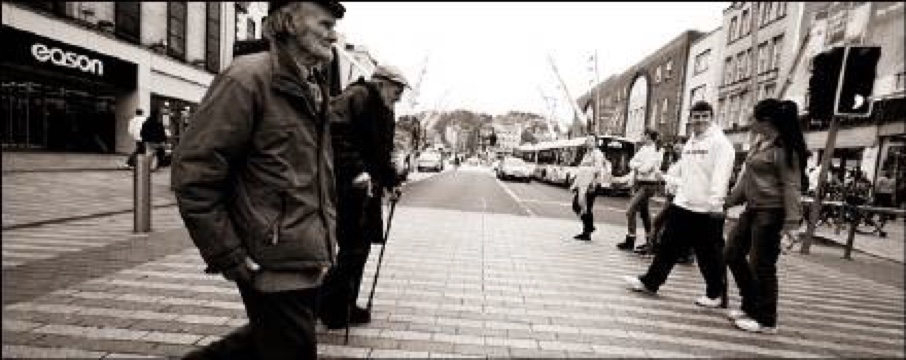A man came up to my my friend Trevor in New York in the early 80s and handed him a sheaf of densely typed foolscap. The man told my friend to read the document because it was very important. It turned out be a detailed account of an extraordinary project involving what could be called ‘surveillance theatre’.
The account opened harmlessly enough: the narrator – who is never named – is hiking on the Appalachian Trail, seventy miles north of Bangor, Maine. He spends the night in a log cabin and is befriended by a man named Duncan Boland who asks him questions about politics, the nature of reality and God. It immediately becomes clear to the narrator that Duncan ‘had been chosen to be my companion by government intelligence.’ Descending the mountain the next day the group meets a muscular woman who offers to guide them down. She advises them to avoid some boulders and leads them to a narrow ledge overlooking a one hundred foot drop.
When the narrator has traversed the ledge he realises that the correct and safer route led over the boulders. ‘Despite over four years of harassment and threats,’ the narrator remarks ‘I hadn’t realized until that moment, how determined the secret police were to scare me.’

His uneasiness was not allayed by the fact that, as he hiked on, ‘my companions were four moose, a bear, several deer and at least forty secret police and collaborators.’ Returning to New York he sought accommodation. The secret police had already selected and prepared an apartment for him on East 11th Street. As he ruefully observes ‘The apartment provides me with a place to live but it also provides the secret police with a living environment they control’.
The full and startling scope of the narrator’s misfortune is then summed up. ‘The building where I live, the surrounding buildings and the neighborhood serve as a theatrical set; and the ‘tenants’ of my building, neighborhood characters, and intelligence agents stage a theatrical production.’ Not only have the secret police located him where they want him, ‘they calculated that everything about the apartment building, neighbors and neighborhood would make me feel as if I had reached the end-of-the-line.’ ‘The neighborhood is an oppressive scene of poverty and desolation: great piles of uncollected garbage line the sidewalks, litter is strewn everywhere…’ ‘For several months, whenever I entered or left the building, two angry German Shepherds on the second floor would howl furiously and claw at their door.’
It wasn’t just the animals and the dilapidation, however. ‘The number of tenants seems to change every month but approximately fourteen people pretend to live in the building… a mad looking bag lady, a sleeping derelict, a sleeping teenage boy…a topless fifty year old woman wearing only white panties, a man waving a knife…I believe I am the only person who lives in the building, but there are probably rotating twenty-four hour guards to provide protection and to prevent any unauthorized visitors. Among the attempts to make the building seem “real” and inhabited are: putting phony mail in the mailboxes, collecting garbage from elsewhere and filling the building’s trash cans,and placing people in various apartments to make a variety of noises as I pass by; frequently playing radios, televisions, and musical instruments; and staging loud conversations or arguments.’
The scheme was nothing if not comprehensive. ‘The secret police have imposed upon me a substitute reality; they have dismembered and appropriated the real world and placed me in a labyrinth of intelligence operations… At any given moment several intelligence agents work together choreographing street theater and surveillance operations.’ The operations are carefully designed to simulate ordinary street life, and they require large casts of actors. ‘As I approach the intersection, a signal is given and people, most of whom are young men, start crossing the intersection from every direction; people walking on the sidewalk, boys riding by on bikes,and other people driving by in cars. Intelligence agents frequently use this kind of collaborator saturation placement at other intersections.’

The narrator continues in this fashion for several pages. Hundreds of collaborators are employed to create the street scenes through which he walks daily and he must learn, amongst other things, to resist eye contact with handsome young men who may entrap him or dealers who attempt to compromise him by offering him illicit drugs. Not a single aspect of everyday city life has escaped the choreographic machinations of the secret police.
I guess I first read the document back in the 80s, possibly not so long after it had been written. It is, by any standard, remarkable and it elicits assessments that clearly equip the reader with a small number of available attitudes: the writer is raving mad; the writer is a good, articulate writer with an exceptional imagination; the writer has an illness but could be treated in such a way that he would see the misjudgments he is making; the writer sees truths that are too painful for him to confront; the writer sees truths that are too painful for us to confront. These various positions were current in the 80s and persist today. What has changed is the level of eccentricity attributable to the individual who generates such a body of perceptions. In Part 2 I’ll look at this in more detail.
04.06.2009
Continued in ‘Stage & Screen 2’..
